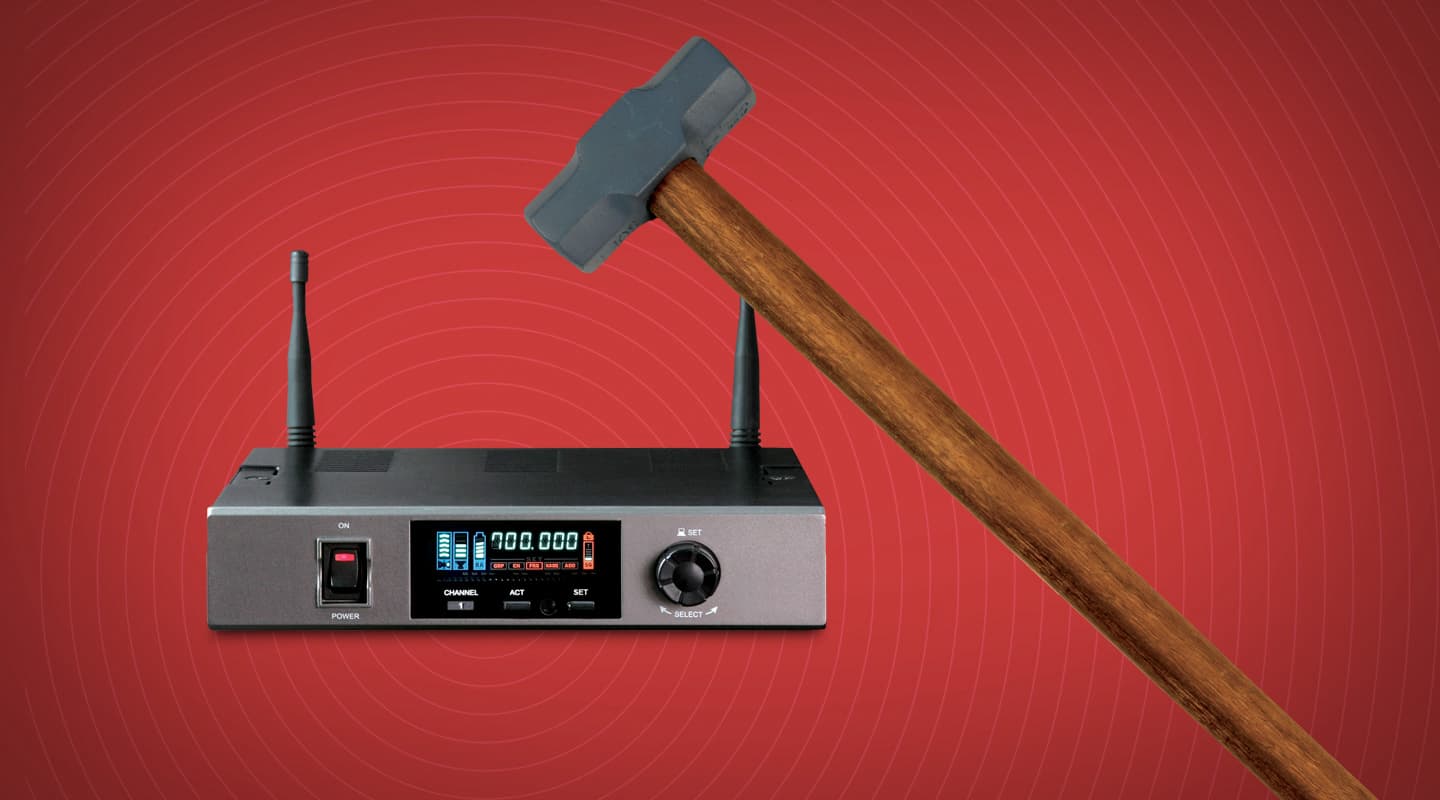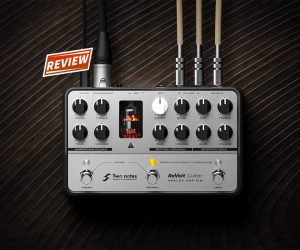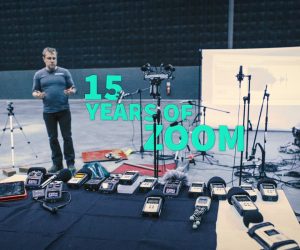
Boring But Important: Cutting the Cord on Wireless Audio
Do you own or run a wireless audio device? Well, it’s likely that Senator Conroy’s Digital Dividend will affect you. Ian Harvey from ACETA lays out the gory details.
Senator Conroy’s Digital Dividend is going to do wonders for mobile internet. At the beginning of 2014, the major telcos will face off in an auction for portions of Australia’s wireless spectrum and begin the process of rolling out better coverage to its customers. Great, right? Who knows, maybe even Vodafone might be able to hold on to a few customers until then. Nevertheless, what it means for audio is that users of about 130,000 wireless microphones and in-ear monitors will likely be up the creek. Leaving only about 20-25,000 devices in safe territory.
Sounds scary, and well, for a lot of people it is.
I’ll try and give a concise explanation of the digital dividend, and then let Ian Harvey from ACETA explain where it leaves the audio community for now.
THE DIGITAL DIVIDEND
Analogue television has always been broadcast over a block of radio spectrum from 520–820MHz — 300MHz of bandwidth. With the switch to digital television, the government has rethought its use of that big block of spectrum. At the moment, during the switchover period, digital television channels are still peppered through that big block of spectrum, alongside the analogue ones. But on December 31, 2013 analogue television will be switched off. After that point, the digital television channels will be ‘restacked’ into a smaller part of the spectrum, from 520-694MHz — 174MHz of bandwidth — freeing up the remaining 126MHz of the original ‘broadcast’ spectrum from 694-820MHz (commonly referred to as the ‘700MHz band’) to be broken up and sold to the highest bidders at auction.
Traditionally, wireless audio devices have happily co-existed in this broadcast spectrum under a class license. There are many gaps in between the broadcasted channels, and your radio device would happily just pick out a free channel to use here or there within its operable bandwidth.
Unfortunately, 130,000 devices, the vast majority sold in Australia, operate in that top 126MHz. If you’ve bought a device from one of the major brands since the digital dividend announcement, you’re probably safe, as most have stopped importing devices in that band. But what happens to the rest?
AudioTechnology talked with Ian Harvey from the Australian Commercial Entertainment & Technologies Association (ACETA, the body that represents the manufacturers and distributors of pro audio gear, among other categories like lighting, in Australia) about the state of play with wireless devices post 2013.
ACETA has also been handed the reins of the Australian Wireless Audio group (AWAG), with support from the Australian Music Association (AMA).
Mark Davie: Can you explain how the digital dividend changes specifically affect the pro audio industry?
Ian Harvey: There are really three major potential impacts. The first is that the spectrum that will be available once the digital dividend is in place (sometime after December 31st, 2013) is about 40% less than what we have access to now. So the first question is, particularly in the major markets and major CBD areas of Sydney, Melbourne and Brisbane, how do we fit the equipment we’ve been using over 300MHz in the past into 174MHz. Can we get all the devices, or all the use that we historically have, in this smaller space?
The second user issue is, within that smaller space is there any potential room for growth?
The third issue is that after that December 2013 date, the new owners of spectrum will have paid significant amounts of money, we’re talking billions of dollars to access this spectrum, and they’re going to want the spectrum clean. Although it’s going to take them a little while to build up their own capacities within that spectrum, they don’t want 130,000 radio mics dirtying up the spectrum that they’ve just spent billions of dollars securing.
There’s this sense from the government that the radio microphone people will just voluntarily vacate the space and go off and do something else or buy other devices. After that December 2013 date, the people operating in that space will be breaking the law, as the law’s been changed already. So the question for the government is; are they going to prosecute anybody for operating in that space? Now the indication so far is that initially they won’t, but at some point they will.
MD: So the class license that everyone has been operating under doesn’t exist in that spectrum anymore?
IH: In November last year the class license was amended to that reduced spectrum of 520-694MHz. Theoretically, the date it will become active is the 1st of January, 2014. The Minister hasn’t indicated precisely what that date will be yet but the actual amendment change with the date to be slotted in comes later. The reason they’re not sure when the telcos will take the space they’ve bought at auction is because they don’t know how long it’s going to take to redeploy the TV that’s in that spectrum. All of the TV broadcast has to be reallocated, which may require new transmitters and different frequencies.
2014 will likely become the year where all the TV broadcast channels are moved to the new space that’s been allocated, and then from 2015 the telcos actually take possession of it.
RACE FOR LESS SPACE
MD: So we’ll be losing use of 40% of the radio spectrum. But will there also be a lot less space to operate after the ‘restacking’ of the digital channels within that reduced 520-694MHz spectrum?
IH: Inherently digital is more spectrum efficient than analogue which is why each TV station frequency is 7MHz — that 7MHz can carry the four stations like you’ve seen with the ABC1, 2 & 3, and Nine’s GO!, etc.
Essentially, there are two ways of doing a restack. One is known as ‘interleaved’, which is where they slot stations at opportune points throughout the available spectrum in that 7MHz block. The other is what they call a ‘block’ option, which they’ve opted for. It means that all six TV stations (ABC, SBS, Nine, Ten, Seven and the community station) are given blocks of 7MHz that butt up to each other and all together that block is 42MHz.
So let’s take Sydney for example, because it’s a bit more complicated than Melbourne. Because the TV stations in Sydney can’t get above the hills that separate the northern beaches and Manly there’s a repeater station on the northern beaches which has a different frequency (so you don’t get shadowing and interference from the primary broadcast), which is a different 42MHz block from the original block. And then as you move further up to the Central Coast there’s another block of 42MHz, and when you get to Newcastle there’s another block of 42MHz. So across the whole spectrum there are four patches of these 42MHz quilted across the geography of the country.
What we don’t know just yet for radio microphones and the non-broadcast environment is where those blocks will be. What will the primary block of 42MHz be in Sydney and Melbourne and Adelaide? Once we know where they are, we can look at the sweet spots for wireless audio devices in and around that.
WHO’S IN TROUBLE?
MD: How many people will be caught out with limited-bandwidth devices that are stuck in the middle of a 42MHz TV channel block?
IH: Let’s look at the people that own product above 694MHz at the moment. So all of that product, and we figure it’s about 130,000 devices that fall into that category, will automatically become illegal and redundant as a result of the shift with the digital dividend. We can be fairly confident about that figure because we’ve got the import numbers.
What we can’t be certain of is just how many devices within the 520-694MHz range will be adversely affected by this change. We think probably there’s between 20-25,000 users in that space, and they will in all likelihood be able to find spectrum that is suitable.
MD: So the vast majority is in trouble?
IH: Yeah. The other thing we’re asking the government — and the response to date has been reasonable and is under consideration — is that in environments where there’s some security for the RF signal, say inside an arts centre building where the prime spectrum is not for TV broadcast, it’s actually for wireless audio use, is to consider providing a primacy for that use where the RF signal is secure and won’t extend outside of that building. It won’t affect people’s television but we can operate across the television spectrum. That’s what all the big productions are doing in any case. What we’re asking the government to do is effectively legalise a practice that has been enjoyed for some period of time.
MD: And have you been given any clues as to what the enforcement of these legal changes might look like? Will vans be going around and sniffing out illegal operators?
IH: It’s the same enforcement regime as we have at the moment. It’s just in a smaller space, and there’s another set of powerful players involved, the telcos. We’re having discussions with likely owners of the new spectrum. We believe that the ACMA is not going to go driving around in vans looking for wireless audio use in areas where there is television.
What will happen though I think is what happens now: if there’s regular and sustained degradation of a TV signal and the complaint goes to the ACMA then they might look at that specific complaint and see if there’s any cause that may relate to radio microphones in that area. The same might apply to digital devices like Telstra’s devices and those sorts of things. I mean, it’s not like analogue where you can get some degradation and both sides still have some capability to work. Digital is either on or off. And whoever has got the most power in that spot wins and it could be that if you’re in a club environment then radio microphones may be more powerful than the handheld telephone-type devices.
MD: What is the prevailing consensus? Is it more likely that wireless microphones will be dirtying up the telco’s new space or the other way around?
IH: We’ve actually had some discussions with Telstra given that we know they’ll be one of the successful bidders for the spectrum. They have a view that in the majority of cases they think they are more powerful than a radio mic and that if there was a radio mic and a Telstra device next to each other and only one could get through, they would generally win. But there have been some instances around the world where these white space devices and handheld telecommunications devices have been defeated by radio mics. Some of their new devices are only starting to come onto the market now, or be bench-tested. So the ability to test who impacts on whom more often than not is just on the cusp of being able to take place.
He bankrolled this hopeless bunch of kids and gave us the keys to a very expensive, well-kitted out studio, and told us to go for it
THE GAPS IN THE PLAN
When the ‘700MHz band’ gets sold off as the digital dividend, one plan is to break up that spectrum into two main 45MHz blocks, one would be used as an uplink for mobile internet, and the other a downlink. In between the two would be a mid-band gap of about 10MHz to stop any interference between the two directions of traffic, and on the edges of the two blocks would be guard bands, to prevent interference with the next spectrum allotments.
IH: The mid-band gap has to exist because the relative strength of the up and down signals for those devices. Those signals go through the same transmission tools, towers, and communications pieces and equipment, so that’s why they need to have the mid-band gap as a guard to avoid crosstalk between the upload and download of the data flow in mobile telephone-style devices.
Because we’re not actually connected to any of that infrastructure, we would consider that from the very edges of the mid-band gap probably 8MHz of that guard band is usable. But it does need to be tested and that hasn’t taken place yet.
We think it is primarily usable for what we call ‘community users’ — churches, schools and those organisations who are running a few devices. Our advice at the moment is one radio mic per single MHz. So if we had 8MHz available through the mid-band gap allowing for a guard band of 1MHz at either end we could probably run eight devices. We think there’s some capacity there that would relieve some of the pressure off the main broadcasting.
It’s otherwise unused space. There are other people that could probably use it. There’s a bit of wireless that’s done in medical monitoring. We put our hand up to say we’re interested in the space, subject to suitable testing regimes.
WHAT’S MY STANDING?
MD: Would compensation programs be similar to those seen in the U.S.?
IH: We see that we’re in a different position from the U.S. and also from Britain. We’re the only one of those countries so far that actually has a license arrangement. The way wireless audio worked in The States, and the UK, was if you registered it you had some protections. But the vast majority of users in both of those countries have never registered their product so they were more or less squatting in that space.
The difference here is that through the Low Interference Portable Device (LIPD) class license we actually have a formal licensed position. As long as the product people buy and import meets those license conditions then our users have a legal right… well, had a legal right, to use that equipment in ways that they see fit, provided the equipment meets the requirements.
MD: So there’s more onus on the government to provide some sort of compensation because of that legal standing?
IH: There’s at least room for the argument to be had. The government isn’t keen on doing that but there’s certainly some solidity to having the argument because our users clearly aren’t squatting in the way that they were in The States. The question, of course, is: does the government want to fork out the money to change these devices over?
MD: So what’s your recommendation for people who want to buy wireless gear?
IH: There are two things they need to do. They need to buy products that operate between 520-694MHz, which is what they’ll be able to buy from most of the major brands. But they should confirm that with their retailer and to ensure that is the case. Then they should buy a product that is as spectrally agile as they can afford. So anything that has a range of 80MHz should not have any problems operating. Even with 40MHz, unless you’re really unlucky and find yourself right in the middle of that 42MHz block, you’ll find spectrum that will work for you legally.
MD: And for people that have lots of gear in that 700MHz range?
IH: Well, we’ll just have to wait and see what transpires. They’ve got a right to continue to use it until at least December 2013 so they’ve got another 18 months or so.
The two things we’re hoping to secure in our next meeting are an education program, so people actually know what’s going on, and to find out if there’s going to be a compensatory package or environment, and how that is going to work. We need to be able to tell people what’s likely to happen. The allocations of those 42MHz blocks, post restacking, was due mid-year, but I’ve got a sense that they’re dragging their feet on that, I’m sensing more like September/October.
















RESPONSES